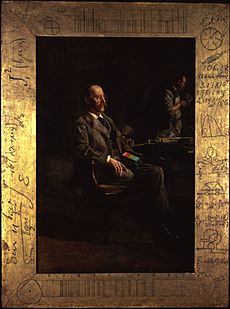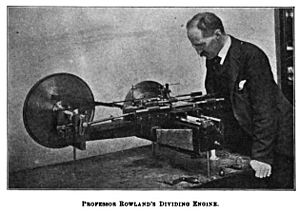Henry Augustus Rowland facts for kids
Quick facts for kids
Henry Augustus Rowland
|
|
|---|---|
 |
|
| Born | November 27, 1848 Honesdale, Pennsylvania, U.S.
|
| Died | April 16, 1901 (aged 52) |
| Alma mater | Rensselaer Polytechnic Institute |
| Known for | Diffraction grating Rowland circle Rowland ring |
| Awards | Rumford Prize (1883) Henry Draper Medal (1890) Matteucci Medal (1895) |
| Scientific career | |
| Fields | Physicist |
| Institutions | University of Wooster Rensselaer Polytechnic Institute Johns Hopkins University |
| Academic advisors | Hermann von Helmholtz |
| Doctoral students | Joseph Sweetman Ames Louis Bell Edwin Hall William Jackson Humphreys Charles Elwood Mendenhall Harry Fielding Reid |
| Signature | |
Henry Augustus Rowland (born November 27, 1848 – died April 16, 1901) was an American scientist who studied physics. He taught at Johns Hopkins University. He was also the first president of the American Physical Society from 1899 to 1901. Rowland is famous for creating very good diffraction gratings. These tools helped him study the light from the sun.
Contents
Early Life and Education
Henry Augustus Rowland was born in Honesdale, Pennsylvania. His father, also named Henry Augustus Rowland, was a pastor. From a young age, Henry showed a strong interest in science. He spent his free time doing experiments with electricity and chemicals.
He went to Rensselaer Polytechnic Institute in Troy, New York. He finished his studies there in 1870.
Rowland's Scientific Career
After college, Rowland worked for a railway company. However, he did not enjoy this job. He soon became a science instructor at the University of Wooster in Wooster, Ohio. Later, he returned to Rensselaer as an assistant professor of physics.
Many people considered Rowland one of the smartest American scientists of his time. But at first, his work was not recognized in his own country. He found it hard to get his early scientific papers published. However, a famous scientist named James Clerk Maxwell quickly saw how good Rowland's work was. Maxwell helped get his papers printed in a science magazine.
When Johns Hopkins University in Baltimore, Maryland, was looking for a physics professor, they asked for advice in Europe. Many experts strongly recommended Rowland as the best choice. In 1876, he became the first physics professor at Johns Hopkins University. He held this important job until he passed away in Baltimore on April 16, 1901.
Studying in Berlin
Before starting his job at Johns Hopkins, Rowland went to Berlin. He studied physics there with Hermann von Helmholtz from 1875 to 1876. During this time, he did an important study. He showed that a moving object with an electric charge creates a magnetic field.
Important Experiments in Baltimore
Once in Baltimore, Rowland focused on two major projects. One project was to measure the ohm again. The ohm is a unit used to measure electrical resistance. His measurement was different from what a British committee had found. But eventually, his result was accepted as more accurate.
His other big project was to find the mechanical equivalent of heat. This means figuring out how much mechanical energy turns into heat. He used a method similar to J. P. Joule's paddle-wheel experiment. Rowland made many improvements to the equipment. He also did his experiments over a wider range of temperatures. His results showed a slightly higher value than Joule's final number. He also made important observations about how heat works and how the specific heat of water changes.
Creating Diffraction Gratings
In 1882, Rowland explained his special diffraction gratings to the Physical Society of London. These gratings were a huge help for studying light from stars and the sun. Diffraction gratings are pieces of metal or glass. They have a very large number of parallel lines drawn on them using a diamond point. For these gratings to work well, the lines must be incredibly precise.
To make such accurate lines, Rowland needed very precise and delicate machines. His engineering skills helped him build these amazing machines. The results of his hard work can be seen in his detailed Photographic Map of the Normal Solar Spectrum (1888). He also created the Table of Solar Wave-Lengths (1898).
In his later years, Rowland worked on a system for sending many telegraph messages at once. In 1883, he wrote an important paper called A Plea for Pure Science. This paper helped people understand the link between science in universities and in businesses during the late 1800s and early 1900s.
Honors and Awards

The National Academy of Sciences gave Rowland the Henry Draper Medal in 1890. This award was for his important work in astrophysics, which is the study of physics in space. He also won the Matteucci Medal in 1895. In Baltimore, the Henry August Rowland House was named a National Historic Landmark. This means it is a very important historical place.
See also
 In Spanish: Henry Augustus Rowland para niños
In Spanish: Henry Augustus Rowland para niños
- History of the Tesla coil
- Hopkinson's law
- Magnetomotive force
- Magnetic reluctance
- X-ray emission spectroscopy
- X-ray fluorescence


